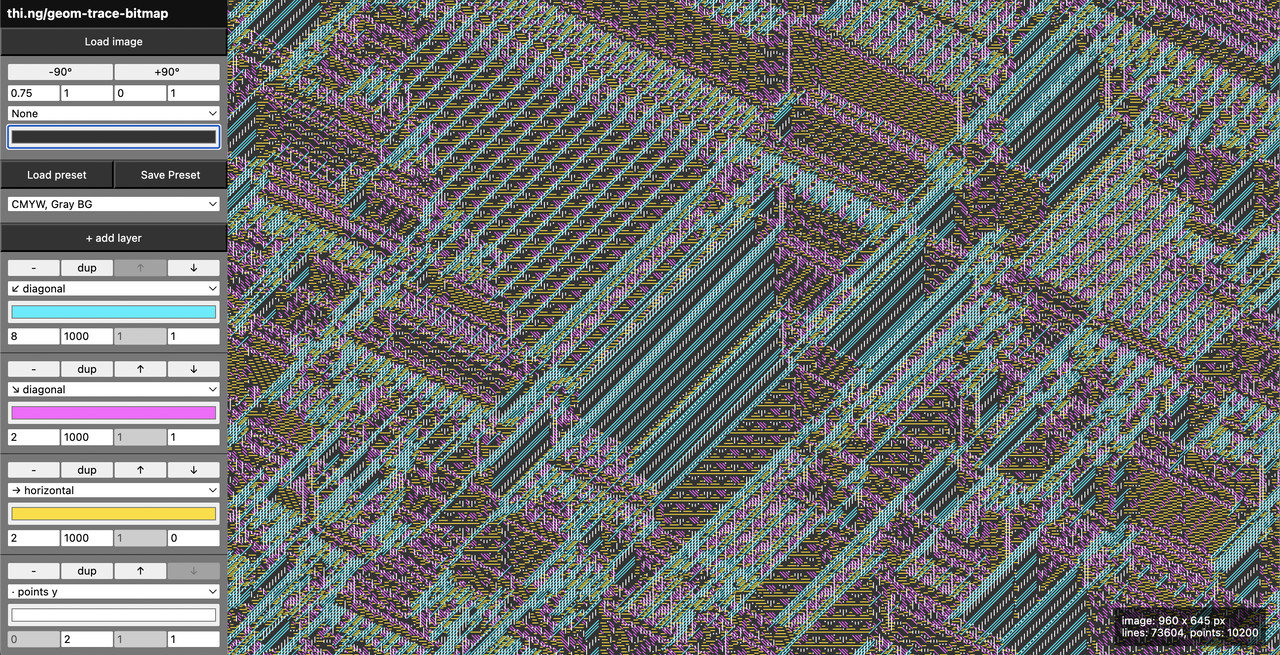
Security News
NVD Concedes Inability to Keep Pace with Surging CVE Disclosures in 2025
Security experts warn that recent classification changes obscure the true scope of the NVD backlog as CVE volume hits all-time highs.
@thi.ng/geom-trace-bitmap
Advanced tools

[!NOTE] This is one of 199 standalone projects, maintained as part of the @thi.ng/umbrella monorepo and anti-framework.
🚀 Please help me to work full-time on these projects by sponsoring me on GitHub. Thank you! ❤️
Bitmap image to hairline vector and point cloud conversions. This is a support package for @thi.ng/geom.
This package provides an extensible setup to extract user selectable
single-pixel width line segments in horizontal, vertical and diagonal (45°)
directions and/or single pixels as 2d point cloud. The main
traceBitmap()
function supports a predicate function to filter qualifying pixel values,
options to control which line orientations should be considered (incl. providing
custom ones and in which order of application), as well as a 2x3 matrix to
transform extracted points (pixel coordinates). See
TraceBitmapOpts
and example below for details.
ALPHA - bleeding edge / work-in-progress
Search or submit any issues for this package
yarn add @thi.ng/geom-trace-bitmap
ESM import:
import * as gtb from "@thi.ng/geom-trace-bitmap";
Browser ESM import:
<script type="module" src="https://esm.run/@thi.ng/geom-trace-bitmap"></script>
For Node.js REPL:
const gtb = await import("@thi.ng/geom-trace-bitmap");
Package sizes (brotli'd, pre-treeshake): ESM: 993 bytes
Note: @thi.ng/api is in most cases a type-only import (not used at runtime)
One project in this repo's /examples directory is using this package:
| Screenshot | Description | Live demo | Source |
|---|---|---|---|
 | Multi-layer vectorization & dithering of bitmap images | Demo | Source |
TODO
For brevity, this example uses
thi.ng/pixel-io-netpbm
to load an image in PGM format. For that image format, the read() function
returns a thi.ng/pixel
IntBuffer using the
GRAY8
pixel format...
import { asSvg, group, line, points, svgDoc } from "@thi.ng/geom";
import { traceBitmap } from "@thi.ng/geom-trace-bitmap";
import { read } from "@thi.ng/pixel-io-netpbm";
import { readFileSync, writeFileSync } "node:fs";
// vectorize bitmap, the returned arrays contain:
// - pairs of vectors (line segments)
// - vectors (points)
const { lines, points: dots } = traceBitmap({
// source image (WILL be mutated!)
img: read(readFileSync("foo.pgm")),
// pixel selection predicate (here to select all bright pixels)
select: (x) => x > 128,
// process horizontals, verticals, diagonals & points (default)
// see: https://docs.thi.ng/umbrella/geom-trace-bitmap/types/TraceDir.html
dir: ["h", "v", "d1", "d2", "p"]
});
// write extracted geometry as SVG file
writeFileSync(
"export/trace.svg",
asSvg(
svgDoc(
{},
group({}, lines.map(([a,b]) => line(a, b))),
points(dots, { fill: "#000", stroke: "none" })
)
)
);
If this project contributes to an academic publication, please cite it as:
@misc{thing-geom-trace-bitmap,
title = "@thi.ng/geom-trace-bitmap",
author = "Karsten Schmidt",
note = "https://thi.ng/geom-trace-bitmap",
year = 2022
}
© 2022 - 2024 Karsten Schmidt // Apache License 2.0
FAQs
Bitmap image to hairline vector and point cloud conversions
The npm package @thi.ng/geom-trace-bitmap receives a total of 277 weekly downloads. As such, @thi.ng/geom-trace-bitmap popularity was classified as not popular.
We found that @thi.ng/geom-trace-bitmap demonstrated a healthy version release cadence and project activity because the last version was released less than a year ago. It has 0 open source maintainers collaborating on the project.
Did you know?

Socket for GitHub automatically highlights issues in each pull request and monitors the health of all your open source dependencies. Discover the contents of your packages and block harmful activity before you install or update your dependencies.

Security News
Security experts warn that recent classification changes obscure the true scope of the NVD backlog as CVE volume hits all-time highs.

Security Fundamentals
Attackers use obfuscation to hide malware in open source packages. Learn how to spot these techniques across npm, PyPI, Maven, and more.

Security News
Join Socket for exclusive networking events, rooftop gatherings, and one-on-one meetings during BSidesSF and RSA 2025 in San Francisco.